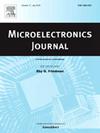An enhanced efficiency 170–260 GHz frequency doubler based on three points resonance matching technique
IF 1.9
3区 工程技术
Q3 ENGINEERING, ELECTRICAL & ELECTRONIC
引用次数: 0
Abstract
This paper presents a full-band frequency doubler (170–260 GHz) with enhanced efficiency based on Schottky diodes. To achieve broadband matching between the matching circuit and the Schottky diode, a three points resonance matching technique (TPRMT) is employed. This technique is developed by considering the embedded impedance matching at three distinct frequency points: upper, middle, and lower, thereby guiding the design of the peripheral matching circuits. In comparison to single frequency point matching, this approach effectively suppresses sideband performance degradation, resulting in improved efficiency. Additionally, the peripheral matching circuits are meticulously designed to fulfill a resonance clockwise impedance trajectory, facilitating matching at the aforementioned three frequency points. Due to the limitation of the input power source, measurements were conducted only within the 170–237 GHz frequency band. The measured results show that the doubler achieves an efficiency ranging from 8.4 % to 14.1 % under an input power of 130–175 mW. The good consistency between simulation and measurement validates the significant advantages of TPRMT.
基于三点谐振匹配技术的 170-260 GHz 高效倍频器
本文介绍了一种基于肖特基二极管的全频段倍频器(170-260 GHz),具有更高的效率。为实现匹配电路与肖特基二极管之间的宽带匹配,采用了三点共振匹配技术(TPRMT)。该技术是通过考虑上、中、下三个不同频率点的嵌入式阻抗匹配而开发的,从而指导外围匹配电路的设计。与单频点匹配相比,这种方法能有效抑制边带性能衰减,从而提高效率。此外,外围匹配电路经过精心设计,以实现顺时针方向的共振阻抗轨迹,从而促进上述三个频点的匹配。由于输入电源的限制,测量仅在 170-237 GHz 频段内进行。测量结果表明,在 130-175 mW 的输入功率下,倍增器的效率为 8.4% 至 14.1%。模拟和测量结果的良好一致性验证了 TPRMT 的显著优势。
本文章由计算机程序翻译,如有差异,请以英文原文为准。
求助全文
约1分钟内获得全文
求助全文
来源期刊

Microelectronics Journal
工程技术-工程:电子与电气
CiteScore
4.00
自引率
27.30%
发文量
222
审稿时长
43 days
期刊介绍:
Published since 1969, the Microelectronics Journal is an international forum for the dissemination of research and applications of microelectronic systems, circuits, and emerging technologies. Papers published in the Microelectronics Journal have undergone peer review to ensure originality, relevance, and timeliness. The journal thus provides a worldwide, regular, and comprehensive update on microelectronic circuits and systems.
The Microelectronics Journal invites papers describing significant research and applications in all of the areas listed below. Comprehensive review/survey papers covering recent developments will also be considered. The Microelectronics Journal covers circuits and systems. This topic includes but is not limited to: Analog, digital, mixed, and RF circuits and related design methodologies; Logic, architectural, and system level synthesis; Testing, design for testability, built-in self-test; Area, power, and thermal analysis and design; Mixed-domain simulation and design; Embedded systems; Non-von Neumann computing and related technologies and circuits; Design and test of high complexity systems integration; SoC, NoC, SIP, and NIP design and test; 3-D integration design and analysis; Emerging device technologies and circuits, such as FinFETs, SETs, spintronics, SFQ, MTJ, etc.
Application aspects such as signal and image processing including circuits for cryptography, sensors, and actuators including sensor networks, reliability and quality issues, and economic models are also welcome.
 求助内容:
求助内容: 应助结果提醒方式:
应助结果提醒方式:


